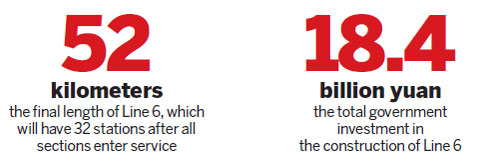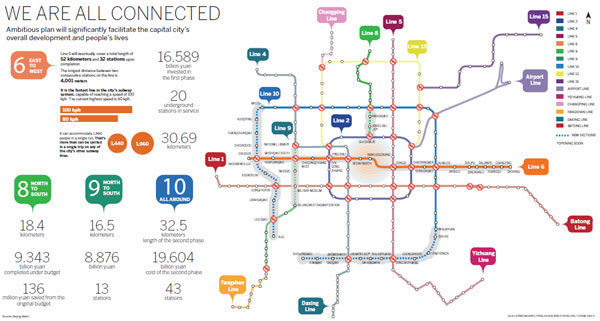Capital's subway system branches out
Updated: 2013-01-04 09:08
By Zheng Xin (China Daily)
|
|||||||||||
Unprecedented construction of Beijing's gigantic underground transit network is expected to alleviate traffic problems that have been haunting the metropolis for decades, reports Zheng Xin.
 |
|
A woman takes photos at Nanluoguxiang Station on Line 6 on Sunday. The station's decoration features the traditional folk art of Beijing. Wei Xiaohao / for China Daily |
The Beijing Subway has seen unprecedented construction in recent years, greatly easing traffic congestion in the Chinese capital.
Including a new line and extensions to lines, the city boasts a network of 15 lines, covering 11 districts, with 221 stations and 442 km of track.
Wang Renqiang, a leading project official of the subway's Line 6 project department of the China Railway Tunnel Group, said once everything is operational, the updated network will make it easier for people to get around and provide relief to transport services on the ground.
The Beijing Subway is the busiest on the Chinese mainland in terms of passenger volume, and the largest in terms of operational length.
It is estimated the total operational length of the Beijing system will reach 1,050 km by the end of 2020, with 30 lines and some 450 stations, according to the Beijing government.
The four new services, which started operating on Dec 30, are Line 6, which connects the east and west of the capital; an extension to Line 10, which will form the capital's second loop line once finished; an extension to Line 8, which connects the city center and northern suburbs; and an extension to Line 9 to serve Beijing West Railway Station.
 |
Line 6 will eventually be 52 km long and boast 32 stations, according to the Beijing Municipal Commission of Transport. This involves three phases, with the entire route becoming operational by the end of 2015.
The first phase is 30.4 km long, with 20 underground stations, while the second will cover another 12.4 km, with seven stations.
According to the commission, the government has so far invested about 18.4 billion yuan ($3 billion) in Line 6, with some 16.6 billion yuan going into the first phase.

The first phase runs from Wuluju in Haidian district in the west of the capital to Caofang in Chaoyang district in the east. Trains can accommodate 1,960 passengers on a single trip, more than can be carried on a single trip on any of the capital's other subway lines.
It is also the fastest line on the system, with trains running at a maximum speed of 100 kph, compared to the current highest speed of 80 kph. Trains will take 48 minutes to travel the whole line.
One of the reasons for the speed is that stations are far apart, with the longest distance between two consecutive stations being four km.
In addition to its capacity and speed, Line 6 also features the deepest station on the system, with the connection to Dongsi Station on Line 5 being 34 meters underground.
The city's subway system is under considerable pressure, with serious overcrowding during rush hours, partly because of the ticket price of just 2 yuan (31 cents) regardless of the length of journey.
Contact the writer at zhengxin@chinadaily.com.cn
Today's Top News
President Xi confident in recovery from quake
H7N9 update: 104 cases, 21 deaths
Telecom workers restore links
Coal mine blast kills 18 in Jilin
Intl scholarship puts China on the map
More bird flu patients discharged
Gold loses sheen, but still a safe bet
US 'turns blind eye to human rights'
Hot Topics
Lunar probe , China growth forecasts, Emission rules get tougher, China seen through 'colored lens', International board,
Editor's Picks

|

|

|

|

|

|





